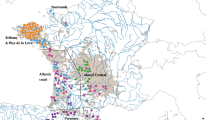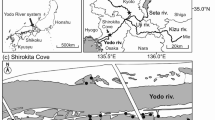Abstract
For the last decades, the European beaver (Castor fiber) has been recolonizing its original habitats. Reintroductions of beavers from different relict populations into southern Germany have resulted in several admixed populations, which are spreading out along various river systems. The eastern part of the German state of Baden-Württemberg is a melting pot of colonization waves originating from various introduced populations. The aim of this study was to exemplify origins and dispersal behaviour of beavers in this region using genetic fingerprint methods. Sequence analysis of hypervariable region 1 (HV1) of the mitochondrial control region and fragment length analyses at 11 microsatellite loci resulted in genetic profiles for 84 samples. The study region is being populated from three different local origins of beavers: the north of the Main-Tauber district, the Neckar River near the city of Mosbach and the Danube tributaries in the east. Main-Tauber samples were most diverse, including microsatellite alleles and HV1 haplotypes specific to C. f. albicus (from the German Elbe relict population). In view of the geographical proximity of this region to a release site of C. f. albicus in the Spessart area, this finding strongly suggests gene flow between beaver populations of different provenience. Two remaining local origins at the Neckar and Danube tributaries are closely related to each other, thus possibly descending from the same original (admixed) population. This study is intended to serve as a starting point for follow-up fine-scale research into dispersal behaviour of European beavers currently recolonizing their original habitats.


Similar content being viewed by others
References
Allgöwer R (2005) Biber (Castor fiber). In: Braun M, Dieterlen F (eds) Die Säugetiere Baden-Württembergs: Insektenfresser (Insectivora), Hasentiere (Lagomorpha), Nagetiere (Rodentia), Raubtiere (Carnivora), Paarhufer (Artiodactyla), Ulmer, Stuttgart, pp 181–189
Benjamini Y, Hochberg Y (1995) Controlling the false discovery rate: a practical and powerful approach to multiple testing. J R Stat Soc B 57(1):289–300
Crawford JC, Liu Z, Nelson TA, Nielsen CK, Bloomquist CK (2008) Isolation and characterization of microsatellite loci in the beaver (Castor canadensis). Mol Ecol Resour 8(3):616–618. https://doi.org/10.1111/j.1471-8286.2007.02016.x
Denk M (2010/2011) Artgutachten: Bundesstichproben- und Landesmonitoring zur Situation des Bibers (Castor fiber) in Hessen. Hessen-Forst FENA
Dežkin VV, Safonov VG (1972) Die Biber der alten und neuen Welt, 1st edn. Die neue Brehm-Bücherei, vol 437. A. Ziemsen Verlag, Wittenberg Lutherstadt
d-maps.com Kostenlose Karten: Deutschland & Bundesländer (n.d.) http://www.d-maps.com/continent.php?num_con=10&lang=de. Accessed 18 August 2016
Durka W, Babik W, Ducroz J-F, Heidecke D, Rosell F, Samjaa R, Saveljev AP, Stubbe A, Ulevicius A, Stubbe M (2005) Mitochondrial phylogeography of the Eurasian beaver Castor fiber L. Mol Ecol 14(12):3843–3856. https://doi.org/10.1111/j.1365-294X.2005.02704.x
Earl DA, von Holdt BM (2012) Structure Harvester: a website and program for visualizing structure output and implementing the Evanno method. Conserv Genet Resour 4(2):359–361. https://doi.org/10.1007/s12686-011-9548-7
Ellegren H, Hartman G, Johansson M, Andersson L (1993) Major histocompatibility complex monomorphism and low levels of DNA fingerprinting variability in a reintroduced and rapidly expanding population of beavers. Proc Natl Acad Sci U S A 90(17):8150–8153
Enserink M, Vogel G (2006) Wildlife conservation. The carnivore comeback. Science 314(5800):746–749. https://doi.org/10.1126/science.314.5800.746
Evanno G, Regnaut S, Goudet J (2005) Detecting the number of clusters of individuals using the software structure: a simulation study. Mol Ecol 14(8):2611–2620. https://doi.org/10.1111/j.1365-294X.2005.02553.x
Excoffier L, Laval G, Schneider S (2005) Arlequin ver. 3.0: an integrated software package for population genetics data analysis. Evol Bioinformatics Online 1:47–50
Frosch C, Haase P, Nowak C (2011) First set of microsatellite markers for genetic characterization of the Eurasian beaver (Castor fiber) based on tissue and hair samples. Eur J Wildl Res 57(3):679–682. https://doi.org/10.1007/s10344-010-0486-6
Frosch C, Kraus RHS, Angst C, Allgöwer R, Michaux J, Teubner J, Nowak C, Canestrelli D (2014) The genetic legacy of multiple beaver reintroductions in Central Europe. PLoS One 9(5):e97619. https://doi.org/10.1371/journal.pone.0097619
Guedj B, Guillot G (2011) Estimating the location and shape of hybrid zones. Mol Ecol Resour 11(6):1119–1123. https://doi.org/10.1111/j.1755-0998.2011.03045.x
Guillot G (2008) Inference of structure in subdivided populations at low levels of genetic differentiation—the correlated allele frequencies model revisited. Bioinformatics 24(19):2222–2228. https://doi.org/10.1093/bioinformatics/btn419
Guillot G, Santos F (2010) Using AFLP markers and the Geneland program for the inference of population genetic structure. Mol Ecol Resour 10(6):1082–1084. https://doi.org/10.1111/j.1755-0998.2010.02864.x
Guillot G, Estoup A, Mortier F, Cosson JF (2005a) A spatial statistical model for landscape genetics. Genetics 170(3):1261–1280. https://doi.org/10.1534/genetics.104.033803
Guillot G, Mortier F, Estoup A (2005b) Geneland: a computer package for landscape genetics. Mol Ecol Notes 5(3):712–715. https://doi.org/10.1111/j.1471-8286.2005.01031.x
Guillot G, Santos F, Estoup A (2008) Analysing georeferenced population genetics data with Geneland: a new algorithm to deal with null alleles and a friendly graphical user interface. Bioinformatics 24(11):1406–1407. https://doi.org/10.1093/bioinformatics/btn136
Hall TA (1999) BioEdit: a user-friendly biological sequence alignment program for Windows 95/98/NT. Nucleic Acids Symp Ser 41:95–98
Hamilton WD (1972) Altruism and related phenomena, mainly in social insects. Annu Rev Ecol Syst 3(1):193–232. https://doi.org/10.1146/annurev.es.03.110172.001205
Hermann N, Voß C, Menzel S (2013) Wildlife value orientations as predicting factors in support of reintroducing bison and of wolves migrating to Germany. J Nat Conserv 21(3):125–132. https://doi.org/10.1016/j.jnc.2012.11.008
Herr J, Schley L (2009) Barbed wire hair traps as a tool for remotely collecting hair samples from beavers (Castor sp.) Lutra 52(2):123–127
Hinze G (1950) Der Biber: Körperbau und Lebensweise. Verbreitung und Geschichte, Akademie, Berlin
Holleley CE, Geerts PG (2009) Multiplex Manager 1.0: a cross-platform computer program that plans and optimizes multipley PCR. BioTechniques 46(7):511–517
Horn S, Prost S, Stiller M, Makowiecki D, Kuznetsova T, Benecke N, Pucher E, Hufthammer AK, Schouwenburg C, Shapiro B, Hofreiter M (2014) Ancient mitochondrial DNA and the genetic history of Eurasian beaver (Castor fiber) in Europe. Mol Ecol 23(7):1717–1729. https://doi.org/10.1111/mec.12691
HydeSoft Computing LLC: DPlot Jr (n.d.). http://www.dplot.com/other.htm#junior. Accessed 3 March 2016
Kalinowski ST, Taper ML, Marshall TC (2007) Revising how the computer program CERVUS accommodates genotyping error increases success in paternity assignment. Mol Ecol 16(5):1099–1106. https://doi.org/10.1111/j.1365-294x.2007.03089.x
Koressaar T, Remm M (2012) Enhancements and modifications of primer design program Primer3. Bioinformatics 23(10):1289–1291
Kühn R, Schwab G, Schröder W, Rottmann O (2002) Molecular sex diagnosis in castoridae. Zoo Biol 21(3):305–308. https://doi.org/10.1002/zoo.10018
Minnig S, Angst C, Jacob G (2016) Genetic monitoring of Eurasian beaver (Castor fiber) in Switzerland and implications for the management of the species. Russ J Theriol 15(1):20–27
Nolet BA, Rosell F (1998) Comeback of the beaver Castor fiber: an overview of old and new conservation problems. Biol Conserv (75):125–137
Peakall R, Smouse PE (2006) GENALEX 6: genetic analysis in Excel. Population genetic software for teaching and research. Mol Ecol Notes 6(1):288–295
Peakall R, Smouse PE (2012) GenAlEx 6.5: genetic analysis in Excel. Population genetic software for teaching and research—an update. Bioinformatics 28(19):2537–2539
Pepper JW (2000) Relatedness in trait group models of social evolution. J Theor Biol 206(3):355–368. https://doi.org/10.1006/jtbi.2000.2132
Pritchard JK, Stephens M, Donnelly P (2000) Inference of population structure using multilocus genotype data. Genetics 155(2):945–959
QIAGEN Purification of total DNA from nails hair or feathers using the DNeasy Blood Tissue Kit (n.d.). https://www.qiagen.com/de/resources/resourcedetail?id=a5a065dc-e287-4a61-b917-9792e25ab42f. Accessed 3 March 2016
Reynolds J, Weir BS, Cockerham CC (1983) Estimation of the coancestry coefficient: basis for a short-term genetic distance. Genetics 105(3):767–779
Safner T, Miller MP, McRae BH, Fortin M-J, Manel S (2011) Comparison of Bayesian clustering and edge detection methods for inferring boundaries in landscape genetics. IJMS 12(12):865–889. https://doi.org/10.3390/ijms12020865
Slatkin M (1995) A measure of population subdivision based on microsatellite allele frequencies. Genetics 139(1):457–462
Syrůčková A, Saveljev AP, Frosch C, Durka W, Savelyev AA, Munclinger P (2015) Genetic relationships within colonies suggest genetic monogamy in the Eurasian beaver (Castor fiber). Mammal Res 60(2):139–147. https://doi.org/10.1007/s13364-015-0219-z
Thompson JD, Higgins DG, Gibson TJ (1994) CLUSTAL W: improving the sensitivity of progressive multiple sequence alignment through sequence weighting, position-specific gap penalties and weight matrix choice. Nucleic Acids Res 22(22):4673–4680. https://doi.org/10.1093/nar/22.22.4673
Untergasser A, Cutcutache I, Koressaar T, Ye J, Fairchloth BC, Remm M, Rozen SG (2012) Primer3—new capabilities and interfaces. Nucleic Acids Res 40(15):e115
Valachovič D (2009-2012) Manual of beaver management within the Danube river basin
van de Casteele T, Galbusera P, Matthysen E (2001) A comparison of microsatellite-based pairwise relatedness estimators. Mol Ecol 10(6):1539–1549. https://doi.org/10.1046/j.1365-294X.2001.01288.x
van Oosterhout C, Hutchinson WF, Wills DPM, Shipley P (2004) Micro-Checker: software for identifying and correcting genotyping errors in microsatellite data. Mol Ecol Notes 4(3):535–538. https://doi.org/10.1111/j.1471-8286.2004.00684.x
Wahlund S (1928) Composition of populations and correlation appearances viewed in relation to the studies of inheritance. Hereditas 11:65–106
Wang J (2007) Triadic IBD coefficients and applications to estimating pairwise relatedness. Genet Res 89(03). https://doi.org/10.1017/S0016672307008798
Wang J (2011) COANCESTRY: a program for simulating, estimating and analysing relatedness and inbreeding coefficients. Mol Ecol Resour 11(1):141–145. https://doi.org/10.1111/j.1755-0998.2010.02885.x
Werle E, Schneider C, Renner M, Völker M, Fiehn W (1994) Convenient single-step, one tube purification of PCR products for direct sequencing. Nucleic Acids Res 22(20):4354–4355
Williams CL, Breck SW, Baker BW (2004) Genetic methods improve accuracy of gender determination in beavers. J Mammal 85(6):1145–1148. https://doi.org/10.1644/BPR-104.1
Acknowledgements
We thank Regierungspräsidium Stuttgart (Referat 56) for the special permit allowing us to set up hair traps. We thank the team at CVUA Stuttgart (Chemisches und Veterinäruntersuchungsamt Stuttgart) and A. Weber (Office for Wildlife Research and Conservation, Jeggau) for providing tissue samples from beavers found dead. We also thank K.-H. Geier (Landratsamt Main-Tauber-Kreis) and the local beaver conflict managers (Biberberater), especially P. Kuch, S. Dehner and K. Fahrmeier, for collecting hair samples and providing information on beaver territories. Additionally, we are grateful to W. Beyer and his team from the Institute of Animal Science of the University of Hohenheim for granting us access to their automated sequencer and to C. Leidenroth for assisting with sample acquisition.
Author information
Authors and Affiliations
Corresponding author
Ethics declarations
Conflict of interest
The authors declare that they have no conflict of interest.
Ethical approval
All applicable international, national and/or institutional guidelines for the care and use of animals were followed.
Additional information
Communicated by: Cino Pertoldi
Rights and permissions
About this article
Cite this article
Mai, S., Weinhardt, M., Allgöwer, R. et al. Recolonizing lost habitat—how European beavers (Castor fiber) return to south-western Germany. Mamm Res 63, 255–265 (2018). https://doi.org/10.1007/s13364-018-0360-6
Received:
Accepted:
Published:
Issue Date:
DOI: https://doi.org/10.1007/s13364-018-0360-6




